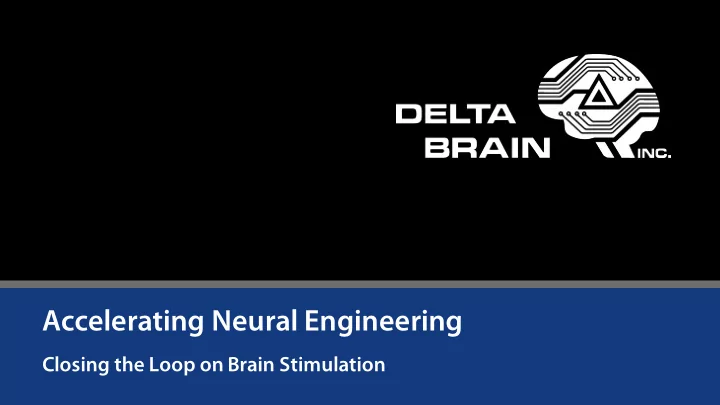

Accelerating Neural Engineering Closing the Loop on Brain Stimulation
Overview This talk is a quick tour of neural engineering, using Parkinson’s Disease as an example. Disclaimer: I’m not a medical doctor, and nothing here should be interpreted as medical advice or an endorsement of any product shown. Talk outline: • Parkinson’s Disease • Deep brain stimulation • Closing the loop and thoughts for the future 2
Parkinson’s Disease 3
Parkinson’s Disease: Facts and Figures • One million Americans live with Parkinson's disease, which is more than the combined number of people diagnosed with multiple sclerosis (MS), muscular dystrophy, and Lou Gehrig's disease (ALS). • 60 thousand Americans are diagnosed with Parkinson's disease each year, and this number does not reflect the thousands of cases that go undetected. • 7-10 million people worldwide are living with Parkinson's disease. • 4% of people with PD are diagnosed before the age of 50 . • Men are 1.5x more likely to have Parkinson's than women. Image credit: James Parkinson’s 1817 “Essay on the Shaking Palsy” via Wikipedia 4 Source: Parkinson’s Disease Foundation, 2016
Parkinson’s Disease: Symptoms and Diagnosis • Tremor • Slowed movement (bradykinesia) • Rigid muscles • Impaired posture and balance • Loss of automatic movements • Speech changes Parkinson’s Normal Disease • Writing changes PET scan • Advanced Stage − Motor symptoms: difficulty swallowing, inability to walk or care for self − Non-motor symptoms: dementia, hallucinations, sleep disorders, depression, and psychosis Image credit: Pacific Parkinson’s Research Centre, University of British Columbia, Canada 5
Parkinson’s Disease: Mechanism • Cause: progressive impairment or deterioration of neurons in the substantia nigra. • When functioning normally, these neurons produce a vital brain chemical known as dopamine. Dopamine serves as a chemical messenger. • Communication between the substantia nigra the corpus striatum coordinates smooth and balanced muscle movement. • A lack of dopamine results in abnormal nerve functioning, causing a loss in the ability to control body movements. Source: webmd.com Image credit: pharmacology2000.com 6
Treatment Challenge: The Blood-Brain Barrier • The blood-brain barrier (BBB) is a protective layer of tightly joined cells that lines the blood vessels in the brain and prevents harmful substances, such as toxins and infectious agents, from diffusing into the surrounding brain tissue [1] • Unfortunately, it also limits the amount of medication that can reach diseased brain targets [1] • While dopamine cannot be given directly, other medications [targeting specific receptors for membrane transport] can increase or substitute for it in the brain [2] Image credit: Focused Ultrasound Foundation [1] Source: Focused Ultrasound Foundation (Interesting approach of using focused ultrasound to disrupt the BBB and allow some drugs to pass through) 7 [2] Source: Mayo Clinic
Deep Brain Simulation 8
Treatment: Deep Brain Stimulation • Conceptually similar to a pacemaker, but delivers a signal to regions deep in the brain to modulate neural firing patterns • Introduced in the 1960s for the treatment of chronic pain • FDA approved for the treatment of essential tremor, Parkinson’s disease, dystonia, epilepsy, and OCD • Also in clinical trials for depression, Alzheimer’s disease, addiction, and more 9
Treatment: Deep Brain Stimulation Image credit: PatricBlomstedt, University Hospital, Umeå via MattiasÅström dissertation Image credit: www.medgadget.com 10
Deep Brain Stimulation in Action 11 Watch this video! - https://youtu.be/0n12yPOUumg Video credit: Medtronic
How Does it Work? Image credit: Maxim Hickmon 12
Fine-Tuning Deep Brain Stimulation In addition to lead placement, can also tune: • Polarity • Frequency • Pulse width • Amplitude Image credit: J Neurosurg 117:955–961, 2012 13
Closing the Loop and Thoughts for the Future 14
Closing the Loop • Stimulation-driven neurochemical release can be measured by fast-scan cyclic voltammetry (FSCV) – apply a small current pulse (nA) and measure response • Existing FSCV electrodes rely on carbon fiber, which degrades quickly during use • New electrodes being developed: boron- doped diamond-based electrodes capable of • Can measure neurochemical release in humans, without in vitro deterioration Source and image credit: Bennet et al. A Diamond-Based Electrode for Detection of Neurochemicals in the Human Brain Frontiers in Human Neuroscience, March 15, 2016 15
The Future: DARPA and the NESD Program • Neural Engineering System Design (NESD) Program (Announced 1/19/16) • “Today’s best brain-computer interface systems are like two supercomputers trying to talk to each other using an old 300-baud modem,” said Phillip Alvelda, the NESD program manager. “Imagine what will become possible when we upgrade our tools to really open the channel between the human brain and modern electronics.” • Neural interfaces currently approved for human use squeeze a tremendous amount of information through just 100 channels , with each channel aggregating signals from tens of thousands of neurons at a time. The result is noisy and imprecise. • In contrast, the NESD program aims to develop systems that can communicate clearly and individually with any of up to one million neurons in a given region of the brain. • DARPA anticipates investing up to $60 million in the NESD program over four years. 16
The Future: Intercepting Spatio-Temporal Codes • Highly recommend "Theodore Berger: Neuroengineering-The Future is Now” video on YouTube Source and image credit: Theodore Berger / USC 17 and the MIT Technology Review
Questions? 18
Recommend
More recommend